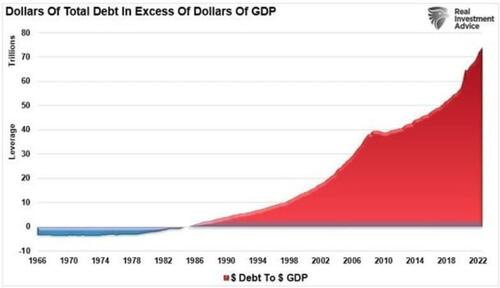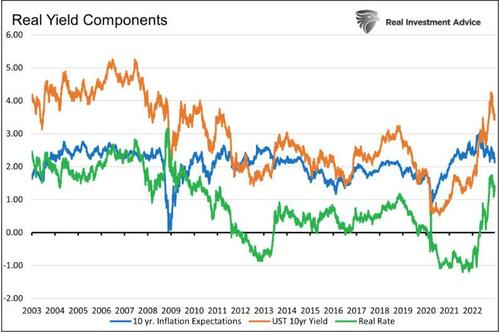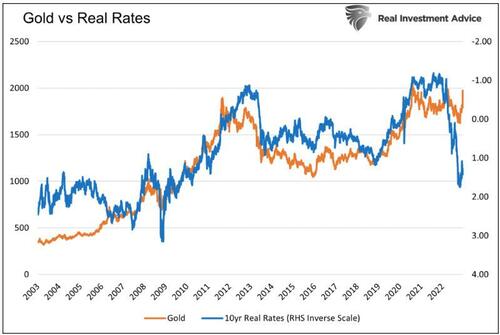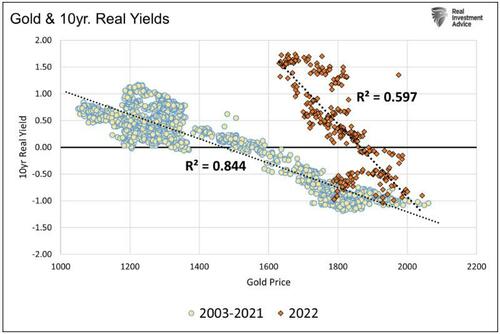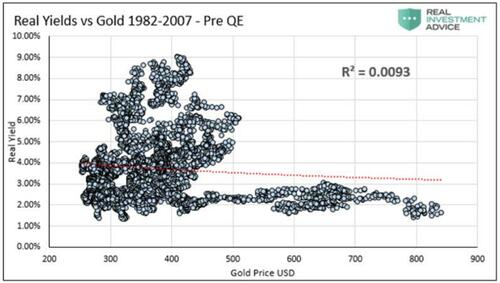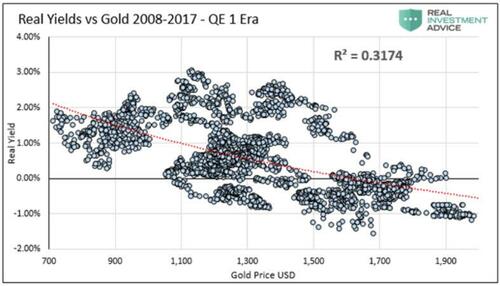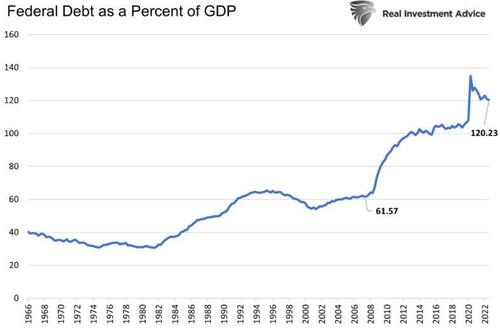
Authored by Michael Lebowitz via RealInvestmentAdvice.com,
By owning gold, investors are not necessarily hedging against a government default but ironically betting the Fed will increasingly misuse monetary policy to help the government avoid defaulting. That may not be the exact thesis gold investors signed up for, but there is ample evidence linking gold prices to Fed behaviors, as we will share.
Financial Mismanagement
Since 2008 government debt has risen twice as much as GDP, as shown in the first graph below. Individual and corporate debt have followed suit. The second graph below shows over $70 trillion of all debt in the U.S. economy, above and beyond annual GDP. That does not include the present value of future obligations, such as social security, which some budget experts argue can easily double the Treasury’s debt load.
Debt has its rules that most issuers must play by. For an individual or corporation, you either pay interest and, ultimately, the principal or default. The government plays by a different set of rules. It can seemingly borrow as much as it wants. They issue debt for current expenditures but also pay for the interest on existing debt and to pay off maturing debt. This scheme works if there are willing buyers for said debt. Doing so requires a helping hand from the Federal Reserve.
The Fed does not print money to fund the government, as many believe. However, they manage interest rates and buy outstanding Treasury debt (QE). Monetary policy, including setting interest rates and QE limits the supply of bonds on the open market and the yields at which they trade. As such, the Fed directly impacts how much the Treasury pays in interest expenses for its debt.
Without the Fed’s help, interest rates would rise as the amount of debt increases versus the nation’s ability to pay for the debt.
Measuring The Fed’s Impact on Yields
Bond yields are a function of supply and demand. The demand side is largely governed by inflation. Bond investors’ appetite grows as the yield increases more than the expected inflation rate over the bond term. Conversely, in a free market, bond investors should be unwilling to buy bonds with yields below the expected inflation rate. Therefore, we can look at real yields to gauge how much help the Fed supplies to the Treasury.
The graph below shows inflation-adjusted or real 10-year UST yields and the yield and inflation expectations used to calculate them. Real yields were generally around +2.00% before the financial crisis. Such a spread aligns well with data going back to 1970. Over those fifty years, real yields averaged 2.30%. Since 2010 real yields have averaged .23%.
In other words, the Fed has likely helped the Treasury reduce its interest expense by approximately 1.75% over the last decade.
Gold and Real Yields
Having established the Fed plays a role in reducing the Treasury’s interest expense, we turn to gold. Gold investors seem to realize that the Fed uses aggressive monetary policies to distort yields. While they have succeeded thus far, they are also devaluing the dollar’s worth. How do we know this?
The graph below shows the strong correlation between gold and real yields over the last twenty years.
The scatter plot below shows the same data in a different format. As shown, the correlation is high. Recently, as highlighted by the orange dots, the slope of the relationship has become more vertical. Essentially, gold prices are not rising or falling as much versus real yields as they did in the prior twenty years. This occurs because the relationship between gold and real yields is much less robust when real yields are positive, as they have been for the last year.
Fed’s Golden Footprint
Our thoughts in this piece tread on similar ground as The Fed’s Golden Footprint. The article highlights various periods in which the Fed let free market forces dictate yield levels and others when the Fed was unduly pressuring yields lower than they should be.
Per the article:
- The first graph, the Pre QE period, covers 1982-2007. During this period, real yields averaged +3.73%. The R-squared of .0093 shows no correlation.
- The second graph covers Financial Crisis-related QE, 2008-2017. During this period, real yields averaged +0.77%. The R-squared of .3174 shows a moderate correlation.
- The last graph, the QE2 Era, covers the period after the Fed started reducing its balance sheet and sharply increasing it in late 2019. During this period, real yields averaged +0.00%, with plenty of instances of negative real yields. The R-squared of .7865 shows a significant correlation.
The bottom line, gold prices are highly correlated with real yields when real yields are near or below zero. The correlation is negative, meaning that as real yields fall, gold prices rise. Said differently, gold prices increase when the Fed enacts a monetary policy that is too stimulative given the circumstances. Other than the last year, that has been the case for most of the previous 15 years.
Summary
Gold investors are betting the Fed will continue to be negligent with its monetary policy. Without the Fed’s help, the free market would impose interest rate discipline on the Treasury and Congress. Higher rates would force our leaders to run budgets that align with the tax base.
Currently, real yields are at the highest levels in over a decade. As a result, gold has been trading poorly. Looking ahead, we must ask how long the economy can withstand high real yields. We guess economic growth will eventually falter, financial markets will swoon, the Treasury will start to balk at high-interest expenses, and the Fed will ride to the rescue. They will aggressively reduce rates to bring real yields back to zero or below in such a situation. Such a scenario bodes well for gold.
However, if the Fed maintains its hawkish stance, real yields will stay positive, and gold prices may continue to languish. Hopefully, this article gives gold investors the knowledge to make sound decisions on what environment fosters positive gold price action.
Authored by Michael Lebowitz via RealInvestmentAdvice.com,
By owning gold, investors are not necessarily hedging against a government default but ironically betting the Fed will increasingly misuse monetary policy to help the government avoid defaulting. That may not be the exact thesis gold investors signed up for, but there is ample evidence linking gold prices to Fed behaviors, as we will share.
Financial Mismanagement
Since 2008 government debt has risen twice as much as GDP, as shown in the first graph below. Individual and corporate debt have followed suit. The second graph below shows over $70 trillion of all debt in the U.S. economy, above and beyond annual GDP. That does not include the present value of future obligations, such as social security, which some budget experts argue can easily double the Treasury’s debt load.
Debt has its rules that most issuers must play by. For an individual or corporation, you either pay interest and, ultimately, the principal or default. The government plays by a different set of rules. It can seemingly borrow as much as it wants. They issue debt for current expenditures but also pay for the interest on existing debt and to pay off maturing debt. This scheme works if there are willing buyers for said debt. Doing so requires a helping hand from the Federal Reserve.
The Fed does not print money to fund the government, as many believe. However, they manage interest rates and buy outstanding Treasury debt (QE). Monetary policy, including setting interest rates and QE limits the supply of bonds on the open market and the yields at which they trade. As such, the Fed directly impacts how much the Treasury pays in interest expenses for its debt.
Without the Fed’s help, interest rates would rise as the amount of debt increases versus the nation’s ability to pay for the debt.
Measuring The Fed’s Impact on Yields
Bond yields are a function of supply and demand. The demand side is largely governed by inflation. Bond investors’ appetite grows as the yield increases more than the expected inflation rate over the bond term. Conversely, in a free market, bond investors should be unwilling to buy bonds with yields below the expected inflation rate. Therefore, we can look at real yields to gauge how much help the Fed supplies to the Treasury.
The graph below shows inflation-adjusted or real 10-year UST yields and the yield and inflation expectations used to calculate them. Real yields were generally around +2.00% before the financial crisis. Such a spread aligns well with data going back to 1970. Over those fifty years, real yields averaged 2.30%. Since 2010 real yields have averaged .23%.
In other words, the Fed has likely helped the Treasury reduce its interest expense by approximately 1.75% over the last decade.
Gold and Real Yields
Having established the Fed plays a role in reducing the Treasury’s interest expense, we turn to gold. Gold investors seem to realize that the Fed uses aggressive monetary policies to distort yields. While they have succeeded thus far, they are also devaluing the dollar’s worth. How do we know this?
The graph below shows the strong correlation between gold and real yields over the last twenty years.
The scatter plot below shows the same data in a different format. As shown, the correlation is high. Recently, as highlighted by the orange dots, the slope of the relationship has become more vertical. Essentially, gold prices are not rising or falling as much versus real yields as they did in the prior twenty years. This occurs because the relationship between gold and real yields is much less robust when real yields are positive, as they have been for the last year.
Fed’s Golden Footprint
Our thoughts in this piece tread on similar ground as The Fed’s Golden Footprint. The article highlights various periods in which the Fed let free market forces dictate yield levels and others when the Fed was unduly pressuring yields lower than they should be.
Per the article:
- The first graph, the Pre QE period, covers 1982-2007. During this period, real yields averaged +3.73%. The R-squared of .0093 shows no correlation.
- The second graph covers Financial Crisis-related QE, 2008-2017. During this period, real yields averaged +0.77%. The R-squared of .3174 shows a moderate correlation.
- The last graph, the QE2 Era, covers the period after the Fed started reducing its balance sheet and sharply increasing it in late 2019. During this period, real yields averaged +0.00%, with plenty of instances of negative real yields. The R-squared of .7865 shows a significant correlation.
The bottom line, gold prices are highly correlated with real yields when real yields are near or below zero. The correlation is negative, meaning that as real yields fall, gold prices rise. Said differently, gold prices increase when the Fed enacts a monetary policy that is too stimulative given the circumstances. Other than the last year, that has been the case for most of the previous 15 years.
Summary
Gold investors are betting the Fed will continue to be negligent with its monetary policy. Without the Fed’s help, the free market would impose interest rate discipline on the Treasury and Congress. Higher rates would force our leaders to run budgets that align with the tax base.
Currently, real yields are at the highest levels in over a decade. As a result, gold has been trading poorly. Looking ahead, we must ask how long the economy can withstand high real yields. We guess economic growth will eventually falter, financial markets will swoon, the Treasury will start to balk at high-interest expenses, and the Fed will ride to the rescue. They will aggressively reduce rates to bring real yields back to zero or below in such a situation. Such a scenario bodes well for gold.
However, if the Fed maintains its hawkish stance, real yields will stay positive, and gold prices may continue to languish. Hopefully, this article gives gold investors the knowledge to make sound decisions on what environment fosters positive gold price action.
Loading…
